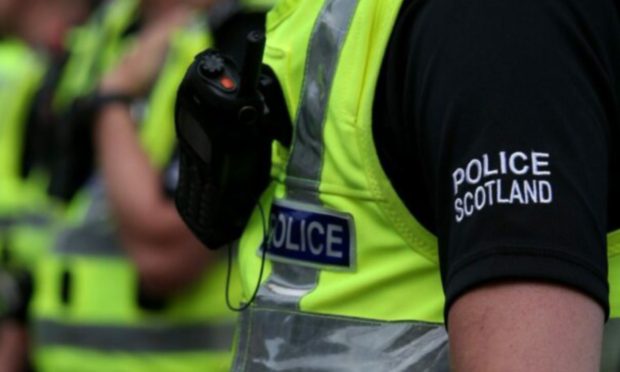Beneath a cloudless sky in the first snap of winter’s frost, an Angus farm field was the weekend setting for a poignant personal tribute to two young airmen of the Second World War.
More than six decades on from the day Sub Lieutenants Arnold Waterhouse and Brian Honeybun (RNVR) died when their Fairey Swordfish biplane plummeted to the ground at Gask Farm on the outskirts of Letham, a new memorial was unveiled in a gathering attended by the nephews of one of the flyers whose practice flight from HMS Condor at Arbroath ended in tragedy.

A wooden cross erected to honour the pair rotted into the ground many years ago, but the original bronze plaque which was unearthed by metal detectorists has now been placed on a permanent stone memorial erected by members of the Waterhouse family, who travelled to Angus for the weekend re-dedication.
In the short open-air service led by Letham minister, the Rev. Dale London just 40 yards from the scene of the 1943 crash, Sub Lieut. Waterhouse’s nephews Andrew and Keith and their wives, Julie and Jeanette were joined by standard bearers and representatives of Legion Scotland and other figures involved in completing the emotional chapter of the family story.
They included farmer David Lumgair, who was just a small boy when the plane plunged into the field, but for many years faithfully creosoted the original wooden cross to protect it from the elements and helped focus the metal detecting search on the area of farmland where the torpedo bomber came down.
Andrew and Keith’s father, Philip was the younger brother, by three years, of Arnold, who was 21 when he met his untimely death.
Although the family have many papers relating to Arnold’s life, his wartime service and the events of February 27 1943, Andrew said it was a subject which was not often spoken about.
“My father died in 2014 and to that day I don’t think he ever got over the loss of his brother,” he said.
“It was a horrific thing for my grandparents to have to endure. We knew there was a memorial and my parents came up a few times, but with the passing of my father a few photographs came to light and that rekindled my interest.”
Keen Angus military historian Patrick Anderson had also completed extensive research into the tragedy, and the memorial plan moved forward when the original plaque was uncovered last December.

As wreaths were laid at the new stone cross, Mr Lumgair said he was pleased the two young flyers will be remembered by future generations of their families.
“I was too young to remember the crash, but every year I used to paint the wooden cross, until it eventually fell down and got lost in the field.
“This was a special service for these two young men and it is nice that the families have erected this cross as a permanent reminder of their loss.”
The Fateful Journey
Sub Lieutenants Arnold Waterhouse, of West Yorkshire and Brian Honeybun, from Middlesex had taken off from Royal Naval Air Station HMS Condor in cloudless skies similar to those which graced the weekend rededication service.
Their Mk 1 Fairey Swordfish K8444 was part of 769 Naval Air Squadron and is thought to have been built in 1937, serving in Malta and Egypt before returning to the UK as part of the second-line squadron at the Angus base.
The inland trip was to have been a routine instrument practice flight, but just a few miles inland from the Arbroath base the biplane developed a fault and the lives of the two young airmen came to a tragic end.
Among the Waterhouse family archives are photographs of Arnold, the telegram informing his parents of the tragedy and a letter of condolence from his commanding officer.

And, from a personal diary, the poignant entries in the days leading up to his death, when the 21-year-old enjoyed a trip to Dundee to “see some of the boys” and a walk along the Arbroath cliffs.
His distraught family would close the diary by marking his final homecoming on March 2 1943, the day before he was laid to rest.












